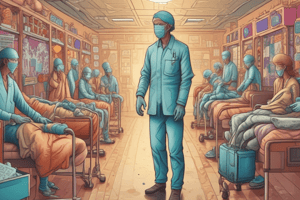Podcast
Questions and Answers
Which clinical feature is most characteristic of herpangina?
Which clinical feature is most characteristic of herpangina?
- Fever, sore throat, and herpes-like lesions on the posterior oropharynx and tonsils (correct)
- Corrugated white lesion on the lateral surface of the tongue
- Firm, white plaques on the cheek, lips, and tongue
- Creamy white patches on the tongue
What is the primary method of reproduction for Candida?
What is the primary method of reproduction for Candida?
- Encapsulation
- Budding (correct)
- Spore formation
- Binary fission
Which immune response is most crucial for controlling systemic candidiasis?
Which immune response is most crucial for controlling systemic candidiasis?
- Complement activation
- Adaptive immunity via T lymphocytes
- Innate immunity via phagocytes (correct)
- Antibody-mediated immunity
What is the typical appearance of thrush in the mouth?
What is the typical appearance of thrush in the mouth?
Which diagnostic test is used to confirm Candida esophagitis?
Which diagnostic test is used to confirm Candida esophagitis?
What is the preferred method for diagnosing herpetic esophagitis?
What is the preferred method for diagnosing herpetic esophagitis?
What is the most frequent initial clinical manifestation of HSV-1 infection?
What is the most frequent initial clinical manifestation of HSV-1 infection?
Which of the following is NOT a typical symptom of orofacial herpes simplex virus infection?
Which of the following is NOT a typical symptom of orofacial herpes simplex virus infection?
Which characteristic finding is associated with infectious mononucleosis caused by Epstein-Barr virus?
Which characteristic finding is associated with infectious mononucleosis caused by Epstein-Barr virus?
What is the classic triad of symptoms associated with infectious mononucleosis?
What is the classic triad of symptoms associated with infectious mononucleosis?
Infectious mononucleosis is serologically indicated by the presence of which of the following antibodies?
Infectious mononucleosis is serologically indicated by the presence of which of the following antibodies?
What is the usual appearance of oral hairy leukoplakia?
What is the usual appearance of oral hairy leukoplakia?
What opportunistic infection is Kaposi Sarcoma-associated Herpesvirus (HHV-8) commonly associated with?
What opportunistic infection is Kaposi Sarcoma-associated Herpesvirus (HHV-8) commonly associated with?
Which cell type is not a primary target cell of the Human Herpesvirus 8 (HHV-8)?
Which cell type is not a primary target cell of the Human Herpesvirus 8 (HHV-8)?
Which of the following is a common hematological complication of infectious mononucleosis?
Which of the following is a common hematological complication of infectious mononucleosis?
What is the primary cause of dental caries?
What is the primary cause of dental caries?
Which infection is characterized by painful blisters around the mouth?
Which infection is characterized by painful blisters around the mouth?
What are the potential consequences of untreated periodontitis?
What are the potential consequences of untreated periodontitis?
Which of the following is a common manifestation of candidiasis in the mouth?
Which of the following is a common manifestation of candidiasis in the mouth?
Which diagnostic approach is commonly used to identify the cause of oral cavity infections?
Which diagnostic approach is commonly used to identify the cause of oral cavity infections?
Which type of infection affects both the gums and the underlying bone structure?
Which type of infection affects both the gums and the underlying bone structure?
Which group of individuals is at higher risk for developing oral thrush?
Which group of individuals is at higher risk for developing oral thrush?
What type of treatment is typically necessary for fungal infections in the oral cavity?
What type of treatment is typically necessary for fungal infections in the oral cavity?
Flashcards
Coxsackie A Virus
Coxsackie A Virus
An RNA virus causing herpangina, characterized by fever, sore throat, and lesions.
Herpangina
Herpangina
A viral infection leading to fever and herpes-like lesions in the throat.
Candida
Candida
A genus of fungi, primarily Candida albicans, that can cause infections when the immune system is compromised.
Thrush
Thrush
Signup and view all the flashcards
Candida Esophagitis
Candida Esophagitis
Signup and view all the flashcards
Herpes Simplex Virus (HSV)
Herpes Simplex Virus (HSV)
Signup and view all the flashcards
Infectious Mononucleosis
Infectious Mononucleosis
Signup and view all the flashcards
Oral Hairy Leukoplakia
Oral Hairy Leukoplakia
Signup and view all the flashcards
Herpetic Esophagitis
Herpetic Esophagitis
Signup and view all the flashcards
HHV-8
HHV-8
Signup and view all the flashcards
Candida Factors
Candida Factors
Signup and view all the flashcards
Viral Transmission
Viral Transmission
Signup and view all the flashcards
EBV Complications
EBV Complications
Signup and view all the flashcards
Candidiasis Diagnosis
Candidiasis Diagnosis
Signup and view all the flashcards
Fungal Commensalism
Fungal Commensalism
Signup and view all the flashcards
Dental Caries
Dental Caries
Signup and view all the flashcards
Periodontitis
Periodontitis
Signup and view all the flashcards
Candidiasis
Candidiasis
Signup and view all the flashcards
Oral Thrush
Oral Thrush
Signup and view all the flashcards
Symptoms of Oral Infections
Symptoms of Oral Infections
Signup and view all the flashcards
Diagnosis of Oral Infections
Diagnosis of Oral Infections
Signup and view all the flashcards
Treatment of Oral Infections
Treatment of Oral Infections
Signup and view all the flashcards
Study Notes
Upper GI Tract Infections
-
Coxsackie A Virus Infection (Herpangina):
- RNA virus
- Symptoms: fever, sore throat, herpes-like lesions on the back of the throat and tonsils
- Affects children (ages 3-10) most commonly
- Predominant in summer and fall
- Later stages can involve ulcerations covered with fibrin
-
Candida Infections:
- Yeasts (fungi) reproduce by budding.
- Gram-positive stain.
- Candida albicans is the most common species, found in various environments (soil, animals, hospitals).
- Candida is a normal human commensal but can become pathogenic due to immune system problems.
- Predisposing factors include antibiotics, chemotherapy, and intravenous catheters.
- Innate (phagocytes) and adaptive (T lymphocytes) immune responses are crucial for controlling Candida infections.
- Oral Thrush: A specific form of oral candidiasis, manifesting as creamy white, curd-like patches on the mouth, tongue, or other mucous membranes. Easily removable, revealing painful raw surface. Often caused by inhaled steroids.
- Other Candida Conditions:
- Acute Atrophic Candidiasis
- Chronic Atrophic Candidiasis ("denture sore mouth")
- Angular Cheilitis (inflammatory reaction at the corners of the mouth; not exclusively Candida)
- Candida Leukoplakia (firm, white plaques, possibly precancerous)
- Candida Esophagitis: Often seen in patients with cancer treatment or AIDS. Symptoms include painful swallowing, feelings of obstruction, substernal chest pain, nausea, and vomiting. Diagnosis involves observing white patches endoscopically.
- Simultaneous Infections: Can occur alongside herpes simplex virus or cytomegalovirus in immunocompromised patients. Confirmed by potassium hydroxide (KOH) tests on scrapings/smears, blood, or tissue cultures.
-
Herpetic Esophagitis and Glossitis:
- Can co-occur with herpes simplex virus or cytomegalovirus infection in immunocompromised individuals.
- Diagnosis preferred via endoscopy.
-
Herpes Simplex Virus (HSV):
- Double-stranded DNA virus.
- Orofacial infection (gingivostomatitis, pharyngitis) is a common initial symptom of HSV-1 infection.
- Recurrent lip lesions (herpes labialis) are common in latent infections.
- Infections are rare deaths in non-immunocompromised people.
- Oral Herpes: Commonly manifested as cold sores. Generally from HSV-1 virus, characterized by painful blisters or sores around the mouth.
-
Epidemiology (Herpesviruses):
- Nearly all adults are infected with HSV-1, VZV, EBV, HHV-6, and HHV-7.
- Transmission typically through direct contact (VZV can sometimes survive in environment).
-
Orofacial HSV-1 Infection:
- Gingivostomatitis and pharyngitis primary infection symptoms.
- Common in children and young adults.
- Symptoms include malaise, muscle aches, difficulty eating, irritability, and swollen neck glands (cervical adenopathy).
-
Epstein-Barr Virus (EBV) Infections (Infectious Mononucleosis):
- Gamma-1 herpesvirus.
- Symptoms: sore throat, fever, and lymphadenopathy (swollen lymph nodes).
- Serologically diagnosed by heterophile antibodies.
-
EBV (Infectious Mononucleosis) Hematological Findings:
-
Mononuclear leukocytosis (abnormal white blood cells called Downey cells).
-
EBV (Infectious Mononucleosis) Complications:
- Autoimmune hemolytic anemia.
- Cold agglutinins (IgM).
- Mild thrombocytopenia.
- Splenic rupture, encephalitis, Guillain-Barre syndrome, Bell’s palsy, and transverse myelitis are possibilities.
- Hepatic and renal manifestations (elevated liver enzymes and blood in urine respectively).
-
Oral Hairy Leukoplakia:
- Corrugated white lesions on the tongue (or other areas).
- Seen in immunocompromised states (AIDS) due to uncontrolled EBV replication.
- Differential diagnosis includes oral candidiasis.
-
Human Herpesvirus 8 (HHV-8) :
- Kaposi Sarcoma-associated Herpesvirus.
- Associated with opportunistic diseases (like AIDS).
- Primarily infects B cells and some endothelial cells, monocytes, etc.
- Common in some regions (Italy, Greece, Africa).
- Most common cancer in sub-Saharan Africa.
Common Oral Cavity Infections
- Dental caries (tooth decay): Caused by acid-producing bacteria (e.g., Streptococcus mutans) attacking tooth enamel, resulting in cavities or holes. Can cause pain, sensitivity, and tooth loss if untreated.
- Periodontitis: An infection of the gums and surrounding tissues, caused by bacteria (e.g., Porphyromonas gingivalis) and plaque biofilm. Leads to gum inflammation, bleeding, receding gums and bone loss.
- Candidiasis (oral thrush): A fungal infection caused by Candida albicans. Common in individuals with weakened immune systems or those taking antibiotics. Manifests as white patches.
Studying That Suits You
Use AI to generate personalized quizzes and flashcards to suit your learning preferences.




